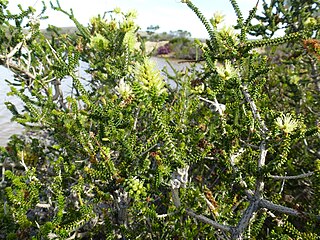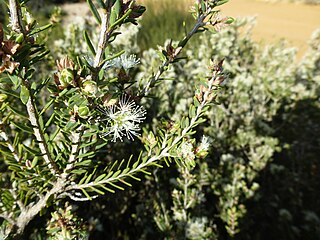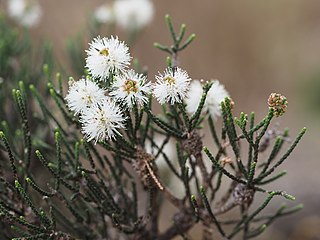
Melaleuca societatis is a plant in the myrtle family, Myrtaceae and is endemic to the south west of Western Australia. It is a dwarf shrub with small, fleshy leaves and many heads of pink or purple flowers in spring, followed by "soccer-ball" fruit.
Melaleuca apodocephala is a plant in the myrtle family, Myrtaceae and is endemic to the south-west of Western Australia. It is a low, bushy shrub with crowded, grey-green leaves, corky bark and a profusion of creamy-yellow flowers on the sides of the branches.

Melaleuca blaeriifolia is an erect to spreading shrub in the myrtle family, Myrtaceae and is endemic to a small area in the south-west of Western Australia. It has small leaves and small greenish-yellow flowerheads.

Melaleuca urceolaris is a low, spreading shrub in the myrtle family Myrtaceae and is endemic to the south-west of Western Australia. Although it is rare in cultivation, it is an attractive garden plant due to its soft foliage and white flowers which fade to pink or red. It is similar to Melaleuca scabra with which it has often been confused.

Melaleuca undulata, commonly known as hidden honey-myrtle is a shrub in the myrtle family Myrtaceae and is endemic to the south of Western Australia. It is a spreading, moderately dense, perennial, woody shrub with creamy-white flowers in small clusters.

Melaleuca leptospermoides is a plant in the myrtle family, Myrtaceae and is endemic to a small area in the south-west of Western Australia. It is an erect shrub with narrow leaves, pinkish or purple flowers and small fruit, and is similar to Melaleuca tuberculata except that it lacks brown bracts at the base of the flowers.
Melaleuca fissurata is a plant in the myrtle family, Myrtaceae and is endemic to the south-west of Western Australia. It is a shrub with rough bark, dished leaves and heads of white or yellow flowers in spring. It is closely related to Melaleuca lateriflora but differs from it in having roughly textured, corky fruit and shorter, convex shaped leaves.

Melaleuca acutifolia is a plant in the myrtle family, Myrtaceae and is endemic to the south-west of Western Australia. It has small, pointed, oval leaves and in summer, heads of white flowers. The species was originally described as a variety of Melaleuca lateriflora but was raised to species status in 2010.
Melaleuca manglesii is a plant in the myrtle family Myrtaceae and is endemic to a small area in the south-west of Western Australia. It is a low, spreading shrub which produces large numbers of heads of purple flowers with yellow tips in spring.

Melaleuca micromera, commonly known as wattle honey-myrtle, is a plant in the myrtle family Myrtaceae and is endemic to a small area in the south-west of Western Australia. It is a rare species with unusual foliage and profuse small yellow flowerheads, making it a plant that is suitable for cultivation, if only to protect it from extinction.

Melaleuca microphylla is a plant in the myrtle family, Myrtaceae and is endemic to a small area in the south-west of Western Australia. It is a bushy shrub with small, crowded leaves and bears a close resemblance to the commonly cultivated Melaleuca ericifolia of the eastern states.

Melaleuca ordinifolia is a plant in the myrtle family, Myrtaceae, and is endemic to the south-west of Western Australia. It is closely related to Melaleuca brevifolia, but is smaller and differing mainly in its leaf features.

Melaleuca parviceps, commonly known as rough honey-myrtle is a shrub in the myrtle family, Myrtaceae, and is endemic to the south-west of Western Australia. It is a shrub with varying shades of pink or purple flowers, the stamens tipped with yellow anthers. In describing it, John Lindley noted: "every twig ... is terminated by hemispherical heads of brilliant pink". It is similar to Melaleuca manglesii and Melaleuca seriata.
Melaleuca polycephala is a shrub in the myrtle family, Myrtaceae, and is endemic to the south-west of Western Australia. It is a sparsely foliaged, twiggy shrub with deep purple flowers in spring.

Melaleuca ringens is a plant in the myrtle family, Myrtaceae, and is endemic to the south-west of Western Australia. It shares some features with Melaleuca diosmifolia but has creamy yellow flower spikes and a lower, more spreading form.

Melaleuca scabra, commonly known as rough honey-myrtle, is a species of shrub that is endemic to a small area on the south coast of Western Australia. It has warty leaves and profuse, pink to purple heads of flowers between July and November.
Melaleuca sciotostyla, commonly known as Wongan melaleuca, is a plant in the myrtle family, Myrtaceae, and is endemic to the south-west of Western Australia. It is an endangered species with only 476 mature plants known in 2001. It is closely related and very similar to Melaleuca haplantha but has narrower leaves and fewer stamens per flower than that species.

Melaleuca seriata is a shrub in the myrtle family, Myrtaceae, and is endemic to the south-west of Western Australia. In describing it, John Lindley wrote "Melaleuca seriata, parviceps, and trichophylla, are bushes, every twig of which is terminated by hemispherical heads of a brilliant pink." It is very similar to Melaleuca parviceps.
Melaleuca subalaris is a plant in the myrtle family, Myrtaceae, and is endemic to the south of Western Australia. It is distinguished by its small, decussate leaves and small flower heads which rarely have more than one flower in each inflorescence.

Melaleuca thyoides, commonly known as salt lake honey-myrtle is a plant in the myrtle family, Myrtaceae and is endemic to the south-west of Western Australia. It is an erect shrub with grey, papery or fibrous bark and very small, overlapping leaves on thin branchlets. It is a salt tolerant species often found on the edges of salt lakes.














